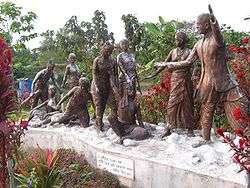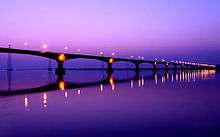Tezpur
| Tezpur তেজপুৰ | |
|---|---|
| Urban Agglomeration(Class I) | |
|
Sunset at Ganesh Ghat near the Brahmaputra, Tezpur | |
| Nickname(s): City of Eternal Romance | |
 Tezpur  Tezpur Location in Assam, India | |
| Coordinates: 26°38′N 92°48′E / 26.63°N 92.8°ECoordinates: 26°38′N 92°48′E / 26.63°N 92.8°E | |
| Country |
|
| State | Assam |
| District | Sonitpur |
| Government | |
| • Body | Tezpur Municipality Board |
| Area | |
| • Total | 40 km2 (20 sq mi) |
| Area rank | 5th |
| Elevation | 48 m (157 ft) |
| Population (2011)[1] | |
| • Total | 102,505 |
| • Density | 2,600/km2 (6,600/sq mi) |
| Languages | |
| • Official | Assamese |
| Time zone | IST (UTC+5:30) |
| ISO 3166 code | IN-AS |
| Vehicle registration | As -12 |
| Website |
sonitpur |
Tezpur (pron: tezˈpʊə) (Assamese: তেজপুৰ) is a city and Urban Agglomeration and the administrative headquarters and municipal board of Sonitpur district in the state of Assam in northeastern India. Tezpur is a fastest growing City on the banks of the river Brahmaputra and is the largest of the north bank towns with a population exceeding 100,000. It is 175 kilometres (109 mi) northeast of Guwahati, considered to be the "Cultural Capital of Assam". Tezpur is also known as the Most Clean City of Assam because of its clean and green view. Tezpur attracts every visitor who comes here with its beautiful parks, hillocks, sceneries and well established hotels.
Geography
The town is on the north bank of the Brahmaputra River.
The rivers in and around Tezpur are fast flowing, especially from the Himalayas foothills. Tezpur has a number of small hillocks, so that flooding doesn't occur during the monsoons.
Climate
The average temperature in summer is around 36 °C (97 °F) while the average winter temperature is around 13 °C (55 °F).[2]
Government
Tezpur is part of Tezpur (Lok Sabha constituency).[3]
Etymology
The name Tezpur is derived from the Sanskrit words 'teza' (meaning blood) and 'pura' (meaning town or city). Legend has it that the original name of this place was 'Sonitpur' ("sonit" in Sanskrit also means blood). When the battle between Krishna's army and Lord Shiva, his disciple Banasura's army fought for the rescue of Aniruddha (who was the grandson of Lord Krishna, according to legend) there was so much bloodshed that the place was stained red. This led to the name of the place becoming Tezpur. The Shiva temples in and around Tezpur shows the love and devotions of King Baanasur for Lord Shiva.
Banasura was the eldest of the hundred sons of Bali, who in turn was the son of Virochana and grandson of Prahlada (son of Hiranyakashipu and devotee of Narasimha). Banas mother was Vindhyavali. Bana, the king of demons (asuras), ruled over Sonita-pura. The word 'bana' also means an arrow.
He went to the Himalayan regions and performed a penance invoking Shiva's favour. When Shiva appeared in answer to his austerities, Bana begged the god to bestow a thousand arms carrying a multitude of weapons to destroy his enemies and opponents. He also desired that Parvati should consider him as her son. Bana was a great devotee of Shiva and there are several famous self manifest bana-lingas being worshipped in India. Banasura was a powerful and terrible asura. All people, the king of earth, and Devas of heaven were afraid of him. Bana was a follower of Siva. Banasura ruled in present-day central Assam with his capital at Sonitpur (present-day Tezpur). Banasura's wife's was Kandala. Banasura had a beautiful daughter named Usha. Usha one day saw a young man in her dream and fell in love with him. He was Aniruddha, the grandson of Lord Krishna. There was a war between Banasura and Krishna in which Banasura was defeated. Krishna married Usha with Aniruddha and brought them to dwaraka. Banasura moved to Himalayas and devoted his life in worship of Shiva
History
Historical ruins from the 8th and 9th centuries dot the surrounding areas. The ruins of Bamuni Hills are the most famous. They resemble Gupta period art. Accordingly, there are plenty of myths as well. The ruins of Da Parbatia are an example of the architecture around the 4th century AD.

Modern Tezpur was founded by the British colonial administration in 1835 as the headquarters of Darrang district. During World War II, Tezpur received large numbers of refugees fleeing from Burma, particularly the corps of Anglo-Burmese and Anglo-Indian nurses. After independence of India in 1947, it remained the headquarters of Darrang district. During the Sino-Indian War of 1962 the Chinese army advanced to the Tawang city, Arunachal Pradesh. The town was evacuated. The jails were opened and the prisoners released.
In 1983 a part of the district was carved out to form a separate district, Darrang. Tezpur was made the headquarters of the new district of Sonitpur.
Rock inscriptions: In 1897, Sir Edward Albert Gait discovered a copper inscription in Tezpur the deciphering of which provided information regarding the Ahom rulers. He referenced the nine line inscription of Harjjar Varma in 'A History of Assam'. The inscription, dating to 829 A.D., is the first historical record of Assam. The inscription was found engraved on a massive stone some 2 kilometres (1.2 mi) from Tezpur town near Rudrapad Temple.
Hazara Pukhuri: A king of the dynasty Harjjar Varma excavated a large pond in 70 acres (280,000 m2) of land, later came to be known as Hajara Pukhuri (Harjjara Pukhuri).
Christian cemetery: The cemetery dates to the 17th century. It contains the grave of Alexander Bruce, founder of the tea industry in India, and of Europeans who died here before independence.
The first electric power station in this part of India was established at Tezpur by the British in 1913.
Jonaki: The first cinema hall of Northeast India was established by Jyoti Prasad Agarwala in 1935.
Chitraban: The first film studio of Northeast India was established by Jyoti Prasad Agarwala in 1934.
The twin lakes Bor Pukhuri and the Padum Pukhuri in the heart of the city memorialize King Bana and his daughter Usha.
Cultural heritage

.jpg)
Tezpur is considered to be the cultural capital of Assamese culture. Being from the core Assamese cultural region, several notables including Dr. Bhupen Hazarika, Jyoti Prasad Agarwala (1903–51), Kalaguru Bishnu Prasad Rabha (1909–69), and Phani Sarma (1909–70), were from Tezpur. Baan Stage was the theatre that was the grooming ground for the famous trio. Also the Nikamal Satra at Mazgaon, a center of Vaishnavaite culture is worth visiting.
Passing through Tezpur, at Dadhara the Jyoti-Bishnu khelpathar is an important attraction. The fields are used for cultural events.
Local dances
- Bihu dance is a group dance of males and females.
- Bagurumba is a Bodo folk dance.
Economy
The economy of Tezpur is dependent on its tea gardens. There are many tea gardens surrounding the town. The gardens and agriculture contribute to the local economy. The Zone III of the Assam Branch Indian Tea Association(ABITA) is located at Tezpur.
Presently Tezpur is a commercial, administrative and educational centre. It also houses a major base of the Indian Army and Airforce (Salonibari).
Demographics
The population is largely heterogeneous. Assamese, Bengali, Nepali, Bihari, Marwari communities form the majority.
People from tribes such as the tea-tribes (brought in by the colonial planters as indentured labourers from the Chhotanagpur plateau region), Bodos, Mishings etc. have also made it their home.
Education and research

- Tezpur University is a central university offering courses in sciences, management sciences, engineering, humanities and social sciences.[4]
- Girijananda Chowdhury Institute of Management and Technology, Tezpur
- The Assam Valley School, One of the best residential school of India is located in Tezpur
- Lokopriya Gopinath Bordoloi Regional Institute of Mental Health[5]
- North Eastern Regional Institute of Water and Land Management
- Defence Research Laboratory
- Indian Statistical Institute, North East Centre
- Department of Electronic Accreditation Computer Course
- Jyoti Kola Kendra (Music/Dance/Art)
- Tezpur Medical College8
Media and communications
Assamese newspaper Dainik Agradoot is published from Tezpur along with Guwahati and Jorhat.
All India Radio has a local station in Tezpur which transmits programs of mass interest.
Tourist attractions
Local areas/sites of interest
- Agnigarh - Also Usha-Aniruddha Udyan
- Bhairabi Temple - Durga shrine also known as Maithan or Bhairabi Devalaya
- Hanuman Mandir - temple of hanuman near the Bhairabi Temple

- Cole Park - Also known as Chitralekha Udyan
- Kolia Bhomora Setu - The 3.015 kilometres (1.873 mi) long road bridge across the Brahmaputra
- Ketakeshwar Dewal - Shiva shrine
- Mahabhairav Temple - Shiva shrine
- Padum Pukhuri - Central lake with an island in the middle
- Rudrapath - Shiva shrine
- Bamuni Pahar
- Da Parbatia Gate of Gupta period
- Hazara pukhuri- Pond of gupta period
- Nag Shankar- Temple of lord Shiva
- Kanaklata Udyan
- Ganesh Ghat temple - (For the temple as well the beautiful sunset of the Brahmaputra)
- Garh Doul - An archaeological site situated at Tarajan Kumargaon, Tezpur.
Transport
Tezpur is connected to the rest of the country by road, rail and air.

In 1987 the Kolia Bhomora Setu, over the Brahmaputra, was inaugurated connecting Tezpur to the southern district of Nagaon. The bridge is the longest over the river, spanning 3,015 metres (3,297 yd), has become a tourist attraction. Dekargaon railway station is the nearest railway station of Tezpur which is about 10 km away from the town. The airport is located at Salonibari, 10 km from the heart of the city.[6]
Notable people
- Hem Barua- Prominent Assamese poet and politician from Assam
- Bishnu Prasad Rabha- Communist political figure
- Jyoti Prasad Agarwala
- Phani Sarma
- Charles Alexander Bruce
References
- ↑ http://www.censusindia.gov.in/pca/SearchDetails.aspx?Id=306544
- ↑ "Tezpur, India Weather Averages - Monthly Average High and Low Temperature - Average Precipitation and Rainfall days - World Weather Online". Retrieved 2 February 2015.
- ↑ "List of Parliamentary & Assembly Constituencies" (PDF). Assam. Election Commission of India. Retrieved 2008-10-06.
- ↑ "Tezpur University, Tezpur, Assam, India, Pin 784028, A Central University". www.tezu.ernet.in. Retrieved 2015-10-22.
- ↑ "LGBRIMH TEZPUR". http://www.lgbrimh.org/. External link in
|website=(help); - ↑ "Kolia Bhomora". Akash Pratim Baruah's website. Archived from the original on October 26, 2009. Retrieved 5 May 2007.
External links
| Wikimedia Commons has media related to Tezpur. |
-
 Tezpur travel guide from Wikivoyage
Tezpur travel guide from Wikivoyage - Sonitpur District
- Tezpur University
- LGBRIMH TEZPUR
- TezpurOnline.in - From Anything To Everything
- TEZPUR IN BRITANNICA
- TEZPUR AT OSGEOINT
.jpg)